The NVIDIA GeForce GTX Titan X Review
by Ryan Smith on March 17, 2015 3:00 PM ESTCompute
Shifting gears, we have our look at compute performance.
As we outlined earlier, GTX Titan X is not the same kind of compute powerhouse that the original GTX Titan was. Make no mistake, at single precision (FP32) compute tasks it is still a very potent card, which for consumer level workloads is generally all that will matter. But for pro-level double precision (FP64) workloads the new Titan lacks the high FP64 performance of the old one.
Starting us off for our look at compute is LuxMark3.0, the latest version of the official benchmark of LuxRender 2.0. LuxRender’s GPU-accelerated rendering mode is an OpenCL based ray tracer that forms a part of the larger LuxRender suite. Ray tracing has become a stronghold for GPUs in recent years as ray tracing maps well to GPU pipelines, allowing artists to render scenes much more quickly than with CPUs alone.
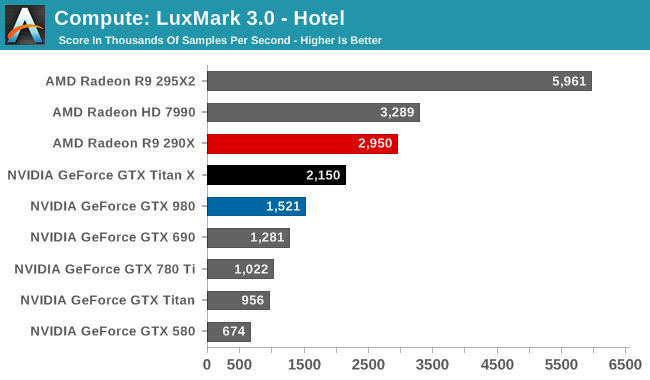
While in LuxMark 2.0 AMD and NVIDIA were fairly close post-Maxwell, the recently released LuxMark 3.0 finds NVIDIA trailing AMD once more. While GTX Titan X sees a better than average 41% performance increase over the GTX 980 (owing to its ability to stay at its max boost clock on this benchmark) it’s not enough to dethrone the Radeon R9 290X. Even though GTX Titan X packs a lot of performance on paper, and can more than deliver it in graphics workloads, as we can see compute workloads are still highly variable.
For our second set of compute benchmarks we have CompuBench 1.5, the successor to CLBenchmark. CompuBench offers a wide array of different practical compute workloads, and we’ve decided to focus on face detection, optical flow modeling, and particle simulations.
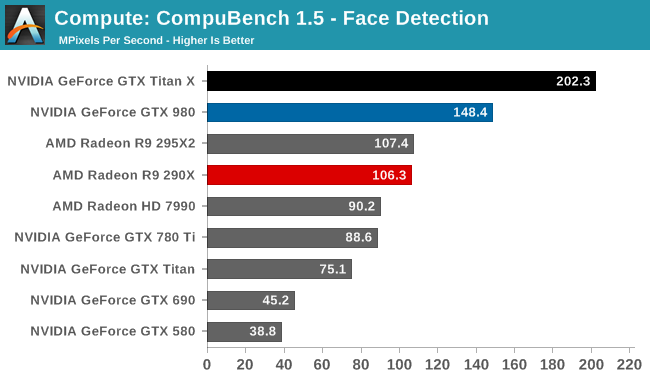
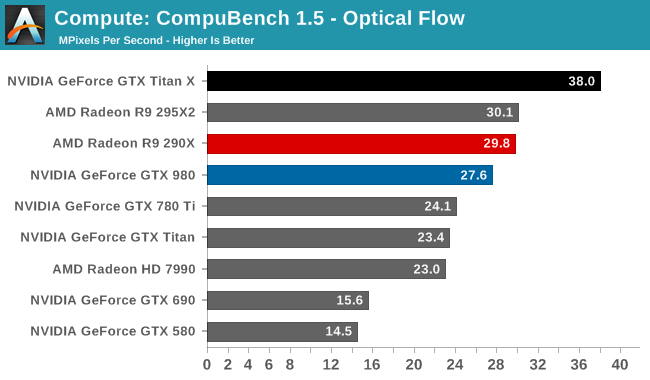
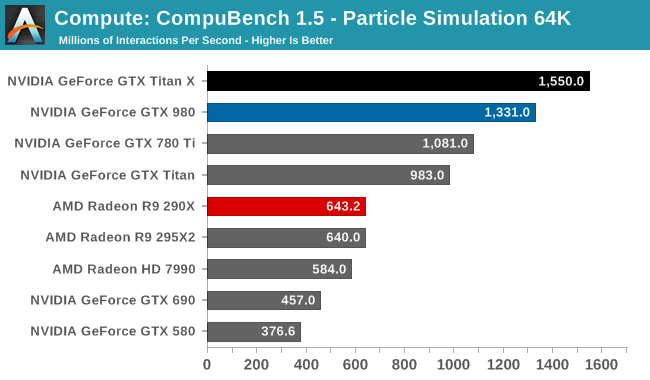
Although GTX Titan X struggled at LuxMark, the same cannot be said for CompuBench. Though the lead varies with the specific sub-benchmark, in every case the latest Titan comes out on top. Face detection in particular shows some massive gains, with GTX Titan X more than doubling the GK110 based GTX 780 Ti's performance.
Our 3rd compute benchmark is Sony Vegas Pro 13, an OpenGL and OpenCL video editing and authoring package. Vegas can use GPUs in a few different ways, the primary uses being to accelerate the video effects and compositing process itself, and in the video encoding step. With video encoding being increasingly offloaded to dedicated DSPs these days we’re focusing on the editing and compositing process, rendering to a low CPU overhead format (XDCAM EX). This specific test comes from Sony, and measures how long it takes to render a video.

Traditionally a benchmark that favors AMD, GTX Titan X closes the gap some. But it's still not enough to surpass the R9 290X.
Moving on, our 4th compute benchmark is FAHBench, the official Folding @ Home benchmark. Folding @ Home is the popular Stanford-backed research and distributed computing initiative that has work distributed to millions of volunteer computers over the internet, each of which is responsible for a tiny slice of a protein folding simulation. FAHBench can test both single precision and double precision floating point performance, with single precision being the most useful metric for most consumer cards due to their low double precision performance. Each precision has two modes, explicit and implicit, the difference being whether water atoms are included in the simulation, which adds quite a bit of work and overhead. This is another OpenCL test, utilizing the OpenCL path for FAHCore 17.
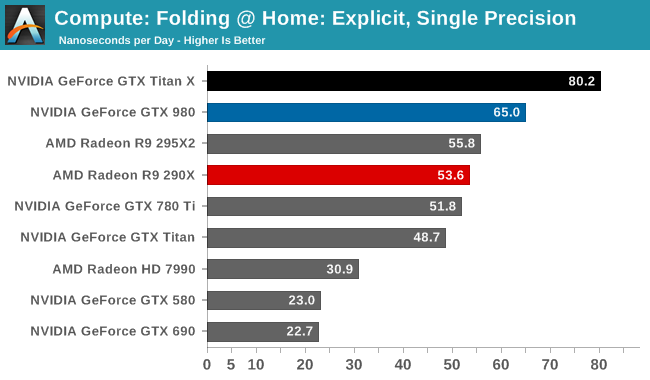
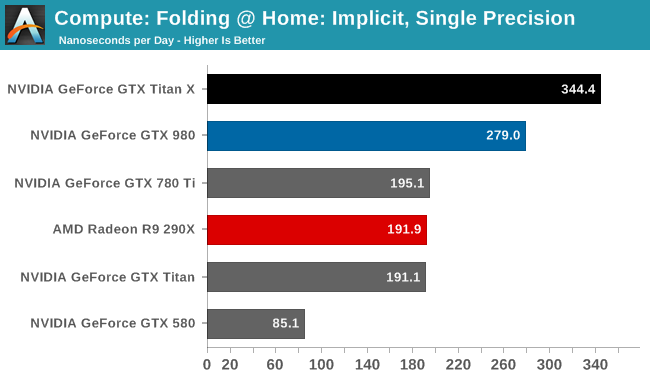
Folding @ Home’s single precision tests reiterate just how powerful GTX Titan X can be at FP32 workloads, even if it’s ostensibly a graphics GPU. With a 50-75% lead over the GTX 780 Ti, the GTX Titan X showcases some of the remarkable efficiency improvements that the Maxwell GPU architecture can offer in compute scenarios, and in the process shoots well past the AMD Radeon cards.
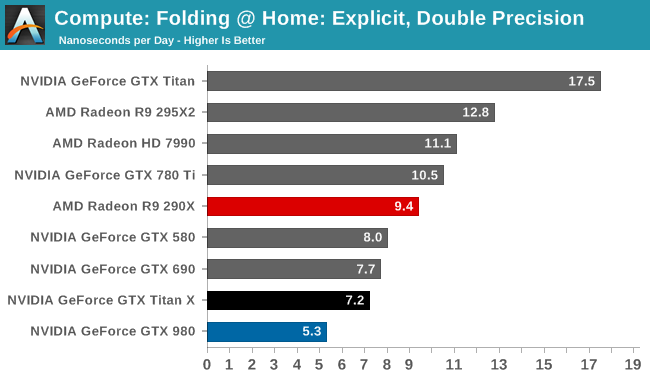
On the other hand with a native FP64 rate of 1/32, the GTX Titan X flounders at double precision. There is no better example of just how much the GTX Titan X and the original GTX Titan differ in their FP64 capabilities than this graph; the GTX Titan X can’t beat the GTX 580, never mind the chart-topping original GTX Titan. FP64 users looking for an entry level FP64 card would be well advised to stick with the GTX Titan Black for now. The new Titan is not the prosumer compute card that was the old Titan.
Wrapping things up, our final compute benchmark is an in-house project developed by our very own Dr. Ian Cutress. SystemCompute is our first C++ AMP benchmark, utilizing Microsoft’s simple C++ extensions to allow the easy use of GPU computing in C++ programs. SystemCompute in turn is a collection of benchmarks for several different fundamental compute algorithms, with the final score represented in points. DirectCompute is the compute backend for C++ AMP on Windows, so this forms our other DirectCompute test.
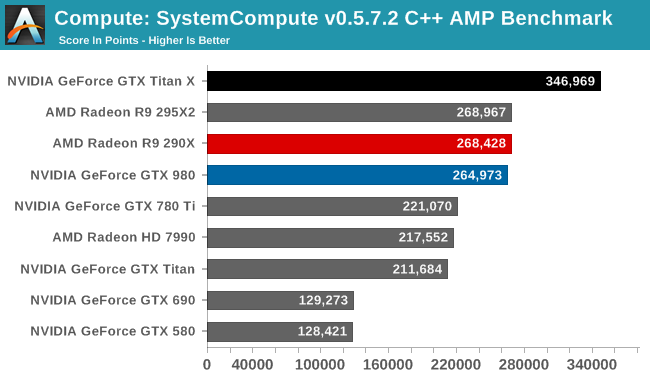
With the GTX 980 already performing well here, the GTX Titan X takes it home, improving on the GTX 980 by 31%. Whereas GTX 980 could only hold even with the Radeon R9 290X, the GTX Titan X takes a clear lead.
Overall then the new GTX Titan X can still be a force to be reckoned with in compute scenarios, but only when the workloads are FP32. Users accustomed to the original GTX Titan’s FP64 performance on the other hand will find that this is a very different card, one that doesn’t live up to the same standards.










276 Comments
View All Comments
Denithor - Wednesday, March 18, 2015 - link
Correct, but then they should have priced it around $800, not $1k. The reason they could demand $1k for the original Titan was due to the FP64 compute functionality on board.This is exactly what they did when they made the GTX 560 Ti, chopped out the compute features to maximize gaming power at a low cost. The reason that one was such a great card was due to price positioning, not just performance.
chizow - Monday, March 23, 2015 - link
@Denithor, I disagree, the reason they could charge $1K for the original Titan was because there was still considerable doubt there would ever be a traditionally priced GeForce GTX card based on GK110, the compute aspect was just add-on BS to fluff up the price.Since then of course, they released not 1, but 2 traditional GTX cards (780 and Ti) that were much better received by the gaming market in terms of both price and in the case of the Ti, performance. Most notably was the fact the original Titan price on FS/FT and Ebay markets quickly dropped below that of the 780Ti. If the allure of the Titan was indeed for DP compute, it would have held its price, but the fact Titan owners were dumping their cards for less than what it cost to buy a 780Ti clearly showed the demand and price justification for a Titan for compute alone simply wasn't there. Also, important to note Titan's drivers were still GeForce, so even if it did have better DP performance, there were still a lot of driver limitations related to CUDA preventing it from reaching Quadro/Tesla levels of performance.
Simply put, Nvidia couldn't pull that trick again under the guise of compute this time around, and people like me who weren't willing to pay a penny for compute over gaming weren't willing to justify that price tag for features we had no use for. Titan X on the other hand, its 100% dedicated to gamers, not a single transistor budgeted for something I don't care about, and no false pretenses to go with it.
Samus - Thursday, March 19, 2015 - link
The identity crisis this card has with itself is that for all the effort, it's still slower than two 980's in SLI, and when overclocked to try to catch up to them, ends up using MORE POWER than two 980's in SLI.So for the price (being identical) wouldn't you just pick up two 980's which offer more performance, less power consumption and FP64 (even if you don't need it, it'll help the resell value in the future)?
LukaP - Thursday, March 19, 2015 - link
The 980 have the same 1/32 DP performance as the Titan X. And Titan never was a sensible card. Noone sensible buys it over a x80 of that generation (which i assume will be 1080 or whatever they call it, based on GM200 with less ram, and maybe some disabled ROPs).The Titan is a true flagship. making no sense economically, but increasing your penis size by miles
chizow - Monday, March 23, 2015 - link
I considered going this route but ultimately decided against it despite having used many SLI setups in the past. There's a number of things to like about the 980 but ultimately I felt I didn't want to be hamstrung by the 4GB in the future. There are already a number of games that push right up to that 4GB VRAM usage at 1440p and in the end I was more interested in bringing up min FPS than absolutely maxing out top-end FPS with 980 SLI.Power I would say is about the same, 980 is super efficient but once overclocked, with 2 of them I am sure the 980 set-up would use as much if not more than the single Titan X.
naxeem - Saturday, March 21, 2015 - link
You're forgetting three things:1. NO game uses even close to 8GB, let alone 12
2. $1000/1300€ puts it to exactly double the price of exactly the same performance level you get with any other solution: 970 SLI kicks it with $750, 295x2 does the same, 2x290X also...
In Europe, the card is even 30% more expensive than in US and than other cards so even less people will buy it there.
3. In summer, when AMD releases 390X for $700 and gives even better performance, Nvidia will either have to drop TitanX to the same price or suffer being smashed around at the market.
Keep in mind HBM is seriously a performance kicker for high resolutions, end-game gaming that TitanX is intended for. No amount of RAM can counter RAM bandwidth, especially when you don't really need over 6-7GB for even the most demanding games out there.
ArmedandDangerous - Saturday, March 21, 2015 - link
Or they could just say fuck it and keep the Titan at it's exact price and release a x80 GM200 at a lower price with some features cut that will still compete with whatever AMD has to offer. This is the 3rd Titan, how can you not know this by now.naxeem - Tuesday, March 24, 2015 - link
Well, yes. But without any compute performance of previous Titans, who would any why buy a 1000 Titan X while having exact same performance in some 980Ti or alike?Those who need 12GB for rendering may as well buy Quadros with more VRAM... When you need 12, you need more anyway... For gaming, 12GB means jack sht.
Thetrav55 - Friday, March 20, 2015 - link
Well its only the fastest card in the WORLD look at it that way the fattest card in the world ONLY 1000$ I know I know 1000 does not justify the performance but its the fastest card in the WORLD!!!agentbb007 - Wednesday, June 24, 2015 - link
LOL had to laugh @ farealstarfareal's comment that the 390X would likely blow the doors off the Titan X, the 390X is nowhere near the Titan X, it's closer to a 980. The all mighty R9 FuryX reviews posted this morning and it's not even beating the 980ti.